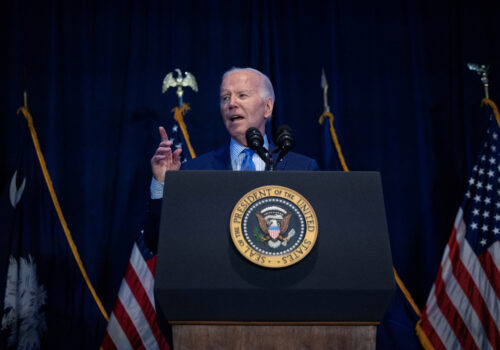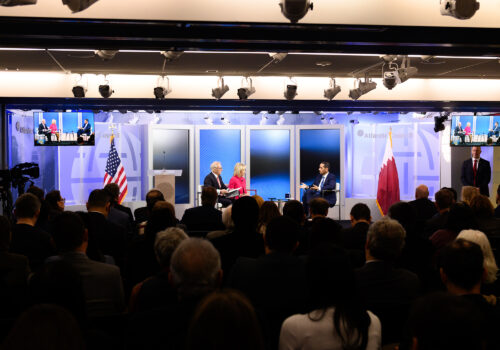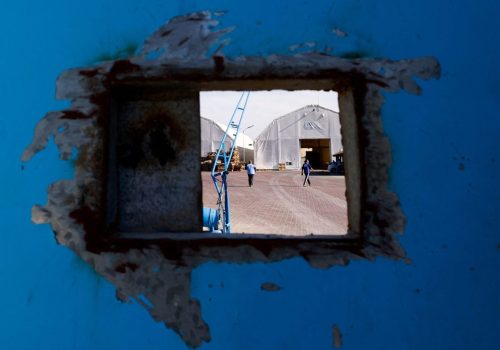The hard truth about Biden’s coming retaliation for the killing of US troops
Ketaib Hezbollah (KH) finally got the picture. President Joe Biden’s statements about US plans for retaliation make it clear that the United States does not have an appetite for war with Iran. But the United States sure has an appetite for KH’s destruction. KH recognizes that the drone attack that killed three US soldiers in Jordan on Sunday puts it squarely in US crosshairs. Oh the impending irony, after years of fighting to push US forces out of Iraq, to be obliterated just months before the United States voluntarily withdraws. To avoid this, KH announced Tuesday night that it is ceasing attacks on US troops in Iraq and Syria. It is a calculated and last-ditch attempt at self-preservation. Based on the immediate KH exodus from its bases after the drone hit, it is plausible that KH did not think the drone would make it past US air defenses in Jordan. The United States should put no stock in KH assurances.
While the threat of US strikes may have KH scrambling, no purely military operation the United States undertakes will “restore deterrence” with Iran. Tehran believes there is no chance the United States will go to war with Iran, not least because the United States keeps saying so. As long as that belief is held, Tehran will continue to cultivate proxies to test the edge of US resolve.
Sunday’s deadly attack hit a nerve in Washington. It is the first time a drone has killed a member of the US military and appears to be the first time a member of the Army or Marines was killed by enemy air power since 1953.
Meanwhile, Iran likely perceived this attack by one of its proxy militias as simply a tit-for-tat retaliation for the Islamic Revolutionary Guard Corps (IRGC) operators killed by the United States’ partner Israel in Damascus a week ago. (From what I’ve heard, Iran believes that it already crossed the rumored US redline about killing Americans in March 2023, when a proxy drone strike in Syria killed a US contractor.)
Add to this the following cruel irony: The US soldiers killed in the attack were in the region supporting the fight against the Islamic State of Iraq and al-Sham (ISIS), the terrorist group that carried out an attack on Iranian soil on January 3. The United States warned Iran of ISIS attack plans, using intelligence collected only because US soldiers are still living in the region and fighting the group. The lives saved with that information were members of Iran’s IRGC, which funds the KH militia that killed the US soldiers.
How will Biden respond to this attack? According to close Iran watchers, Tehran’s decisionmakers feel certain the Biden administration is loath to risk escalation in an election year. They are correct insomuch as American voters do not want the United States dragged into another war in the Middle East. But Tehran’s miscalculation is in projecting the Iranian public’s mindset about the loss of an IRGC member onto the American public’s mindset about the loss of US servicemembers. Americans care, and they will grant their president a greater writ as a result.
When surmising Biden’s likely response, let’s look at the goal—prevent Iran from harming US citizens, interests, and partners—then analyze the likely impact of each option vis-à-vis that goal.
Biden’s menu of options
Option 1: Conduct strikes inside Iran against its war machine. The United States could strike inside Iran and take out its conventional military (Artesh) capabilities, such as aircraft, air defenses, and tanks. But those are not the capabilities causing the US problems. Striking these would not prevent the continuation of the attacks Iran has backed against US forces in the Middle East thus far. And it would drag the Artesh into a beef with the paramilitary IRGC, an organization that competes with the Artesh for funding and authority. In other words, it would bring a large, professional fighting force into a dispute the United States actually has with one of its rivals.
Option 2: Conduct strikes inside Iran against IRGC bases and weapons stockpiles. By targeting IRGC bases and weapons stockpiles in Iran, the United States could test the mythical capabilities of the IRGC’s new Tactical Sayyad air-defense system, the latest brag of the five-year-old Islamic Republic of Iran Air Defense Force. The IRGC has not used its own significant missile arsenal against the United States yet. Strikes would reduce but not remove its ability to do so. But these kinds of strikes would not reduce the likelihood that the United States will continue to face the very same kinds of proxy attacks that US strikes are intended to stop: the kind that just killed US servicemembers. It is certain these would continue—and expand.
Option 3: Conduct strikes against facilities inside Iran that produce the proprietary components the regime smuggles to proxies. The United States could strike sites inside Iran that supply its proxies with weapons and parts. This could possibly slow or prevent attacks, but only after the proxies use up the munitions they have stockpiled for years. In the case of Lebanese Hezbollah alone, this includes more than one hundred thousand rockets.
Iran would not attempt to engage the United States in a war on Iran’s territory. It would choose to demonize the US aggression on its soil and hit the United States around the world on soft targets. It would gain a leg up just keeping the United States busy staying vigilant and pouring resources into hardening every US diplomatic outpost around the world.
Option 4: Conduct strikes against IRGC and proxy capabilities in neighboring states. Iranian proxies in Iraq, Syria, Yemen, and elsewhere in the region are another potential target. However, striking weaponry outside of Iran so far has not deterred Iran or its proxy attacks on US personnel and partners. Iranian assets outside of Iran, beyond proxy assets, could be added to this target list. Mirroring ongoing Houthi targeting, Iranian ships transiting the Red Sea could be included without being considered an escalation.
Perception matters
On Tuesday, Biden told reporters that he has decided on how to respond. As the administration moves forward, it should take steps to manage any reputational risk to the United States from its retaliation. One way to do this is to stick to military targets. Regardless of the breadth and depth of retaliation, if targets are solely military and not on Iran’s home soil, comparative analysis says they are a reflection of Iran’s tactics and therefore non-escalatory.
Another way to minimize reputational risk is to get Jordanian buy-in. Whatever the US chooses to do, Jordan’s backing will help with messaging. The United States does not want to look to the world like it is “overreacting.” Jordan will need to slam some tables more loudly in anger about the breach of sovereignty. This way the United States is cut more slack by other Arab states and other global monarchies if it wages a scorched-earth operation against every IRGC safe house and barn housing boxes of unmanned aerial vehicle propellers from Basra to Beirut.
Expectation management
This short list is not the full gamut of options open to the United States. It does not include, for example, tools such as cyber warfare, military deception, and putting the new Counter Terrorist Financing Taskforce-Israel on steroids. But the list does illustrate that most options fall short of achieving the objective of halting Iran-backed attacks on US personnel, friends, and interests. Success should be defined and expectations should be managed accordingly.
Make no mistake, striking inside Iran will not alter the regime’s course. The regime’s regional objectives—to push the United States out of the region, to eliminate Israel, and to become the dominant regional power in a new world order—do not include language about prosperity for its people or peace in the Middle East. Potential loss of Iranian life will not move them. In fact, striking inside Iran could do the regime a favor.
The regime in Tehran needs an evil “other” right now. Iran will face a leadership transition at the top after its eighty-four-year-old supreme leader, Ayatollah Ali Khamenei, dies. This will create the biggest period of vulnerability the regime has faced. Iran will need to bring the population together in support of a regime policy long enough to minimize the risk of a challenge to its hold on power while the future of the theocracy is in flux. The regime may believe that US strikes will galvanize the Iranian street around a nationalist surge it can ride through the transition.
Neither will bringing an end to the Israel-Hamas war alter Tehran’s course. Despite their displays of support, Iran’s leaders are not concerned about the welfare of Palestinians. While Iranian benefactors sent hundreds of millions of dollars to Hamas and Palestinian Islamic Jihad, they did not direct these groups to use any of these funds to build bomb shelters or stockpile food or fuel for civilians put at risk by their armed provocations of a hardline Israeli government, even before October 7, 2023. Some respected Iran watchers in Washington assess that Tehran was annoyed by the timing of the Hamas assault on Israel, that the decision to unilaterally stage the October 7 attack undermined Tehran’s plans for an eventual larger, multi-pronged proxy move against Israel.
But bringing an end to the Israel-Hamas war will stymie Iran in two ways. One, it will remove the cover the regime is using to promote an appearance of strength domestically and suppress opposition before the period of leadership transition. Iran took advantage of the focus on Gaza and Yemen to attack anti-regime groups in Pakistan, Iraq, and Syria. Legislators in Tehran are pushing through a bill that would increase the powers of the IRGC and the thuggish Basij, the regime’s armed volunteer militia, and leaders have ordered the hanging of an alarming number of 2022 protest participants.
Two, it will remove justification for violent action by Iran’s proxies around the region, at least according to their own mission statements. Iran and its proxies will have to find a new evil “other.”
Kirsten Fontenrose is a nonresident fellow with the Atlantic Council’s Scowcroft Middle East Security Initiative. She is president of the advisory firm Red Six International and a former senior director for the Gulf on the US National Security Council, where she led the development of US policy toward nations of the Gulf Cooperation Council, Yemen, Egypt, and Jordan.
Further reading
Sun, Jan 28, 2024
Experts react: Three US servicemembers were killed in Jordan. Will the US strike back at Iran?
New Atlanticist By
More than 150 attacks on US forces in the Middle East have occurred since October 2023, but the strike overnight was the first to kill a US soldier.
Mon, Jan 29, 2024
Qatar’s prime minister sees progress on Israel-Hamas hostage negotiations—but warns regional tensions are ‘boiling up’
New Atlanticist By Katherine Walla
At an AC Front Page event, Al-Thani discussed talks that took place in Paris over the weekend, which he said made “good progress” on mapping a way out of the conflict.
Tue, Oct 24, 2023
The global consequences of the Israel-Hamas war are just beginning. Here’s what to watch.
The Big Story By Kirsten Fontenrose
It's hard to predict what decisions the players will make tomorrow, but here are the early warning signs that could indicate what will come next in the Middle East and beyond.
Image: U.S President Joe Biden is briefed by members of the national security team in the Situation Room on Monday Jan 29, 2024 on the latest developments regarding the attack on U.S. service members in northeastern Jordan on Saturday night Jan 27, 2024. A drone has struck a tent of sleeping troops in Jordan, killing US troops in the Middle East for the first time since the war in Gaza began. The US has blamed Iran-backed militant groups, but is yet to identify who specifically they believe is responsible. US President Joe Biden said the attack was carried out by radical Iran-backed militant groups in Syria and Iraq on Saturday night.


